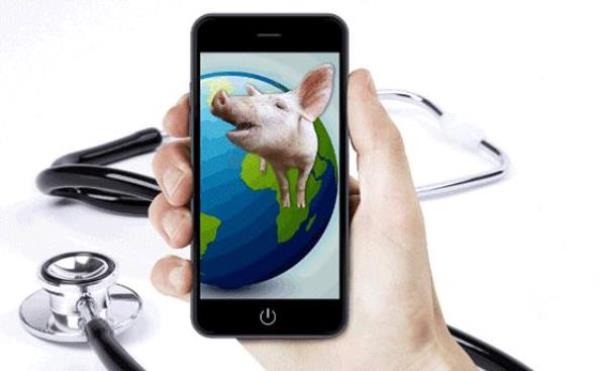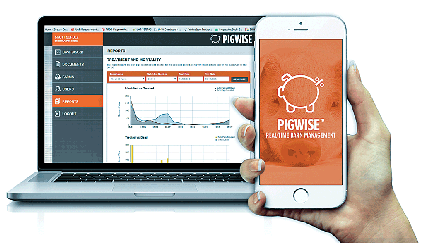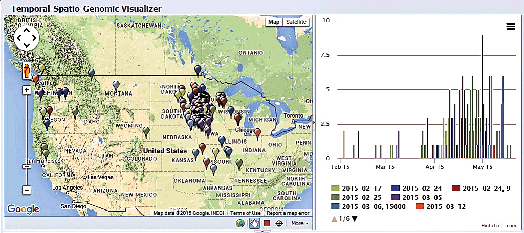Turning to big data to manage animal health
When faced with a problem to solve, it is human nature to want real information instantly.

Most livestock producers would likely agree that completing paperwork and data entry is not their favorite task on the farm. The real challenge is actually investing the time to collect and review data and utilize the information to benchmark performance.
When faced with a problem to solve, it is human nature to want real information instantly. Looking through record after record, searching mounds of paperwork and surfing through Google searches can be frustrating.
Animal health companies realize hog farmers are always struggling with collecting records and mobilizing reliable information. These companies have devoted dollars in creating user-friendly cloud platforms and Web portals to help producers to be profitable and spend more time in the barns with the animals.
Real-time barn management
Tracking herd health in real-time from the barn just got easier with PigWise, a new Web-based tool developed by Zoetis. This virtual reporting platform allows hog farms to share herd health and basic husbandry data with production managers and veterinarians without leaving the barn or passing messy paperwork.
Brett O’Brien, Zoetis senior technical service veterinarian, says, “The most exciting feature to producers is the real-time capabilities of PigWise. In most operations currently, barn records are kept on paper, and there is often a delay for when those paper records get reviewed or uploaded to their data management system. By the time they review that data, a bigger problem may already be occurring in the barn.”
The pork industry is data-driven, with a variety of data captured daily. But the speed and accessibility for analysis is what makes data most useful for hog farms, she adds. PigWise helps fill the communication and documentation gaps within an operation by making it easy to manage records.
User-friendly is the name of the game with PigWise. After an account is created through the local Zoetis representative free of charge, managers or owners can assign a name to each farm, authorize users, create batches for groups of hogs and set thresholds for tracking important health metrics.
From there, the pig caregivers can use the PigWise app on a smartphone to enter daily information for a group of hogs starting from the time the pigs enter the facility. On a basic level, each farm can create customized fields to track daily records like hog inventory, receiving feed, barn temperatures, water intakes, mortalities and medical treatments. Employees can identify sick pigs and use a dropdown menu to classify symptoms, log treatment and document other essential information. PigWise also can work in conjunction with individual pig care training from Zoetis, so caregivers can enter information about sick pigs based on the A, B, C or E classification system.
As soon as the information is entered into the fields on the mobile app and synchronized with the dashboard, that data is readily available for review, O’Brien explains. Production managers and veterinarians can get access anytime to all information entered by caregivers by logging into the app on a smartphone or Web-based dashboard. Upon login, managers and veterinarians will see two options: batches for review and items that need attention. The application records daily metrics on temperature, water consumption and mortalities. Once the metrics fall into a red zone based on established thresholds, it will alert managers and/or veterinarians. Those alerts allow for quicker interventions to improve pig health and performance, O’Brien stresses.
PigWise also has other great features, including the ability for all users to upload a document to share with others. Using the report option, users can create graphs from the metrics gathered to compare data such as cause of death versus treated pigs per day or mortalities versus treated pigs. All information can be exported into an Excel spreadsheet.
Noteworthy, O’Brien says, “PigWise also supports the industry’s commitment to responsible use of antibiotics. When caregivers enter treatment information, they are automatically reminded of label directions for the product, including dosing, route of administration and established withdrawal times. This helps ensure the right product is being used in the right pigs with the right dosage amount and at the right time, which are key to responsible use. In addition, the information being recorded helps satisfy third-party audits on antibiotic use.”
Users of the PigWise system should not worry that the information will be collected by Zoetis or accessed by unauthorized users. All information is securely stored by a third-party Web-based platform where the data is accessible through password-protected access. Producers own their data, O’Brien reassures.
Improved health execution
Merck Animal Health offers hog farmers customized strategies for managing porcine respiratory disease and reproductive performance in two separate Web-based platforms: ResPig and ReproPig.
“The ResPig and ReproPig platforms are part of our strategy to not only provide our customers with great products, but also support them with an integrated offering of tools and services. We are committed to proactively working with our customers to improve their farms on a continuous basis,” says Narciso Bento, global swine business head of MSD Animal Health.
ResPig
The complexity of events that lead to pneumonia in pigs can be challenging for hog operations and can often result in economic losses in the form of reduced feed efficiency and poor growth. Porcine respiratory disease is rarely caused by one pathogen, and certain pathogens such as porcine reproductive and respiratory syndrome virus can be hard to eliminate in herds. When it comes to addressing the porcine respiratory disease complex, the ResPig Management System allows hog farmers, veterinarians and other swine professionals to tailor a PRDC plan for their specific production site.
Users of ResPig can start with the platform’s farm audit to assess the health status of their herds by answering questions on biosecurity programs, vaccination schedules, vaccination quality and management practices. Slaughterhouse checks and laboratory diagnostic data can enhance the audit information. With the platform’s farm simulator, users can evaluate the benefit-to-cost ratio of all possible interventions. This modeling tool takes the information from the audit, along with farm-specific and financial data, to compute a return on investment for PRDC control and prevention strategies. Once these two steps have been completed, the ResPig platform supplies a final conclusion and action items to be considered.
ReproPig
In the same fashion, the ReproPig management system gives hog farmers the tools to maximize the reproductive performance of their herds. Starting with the audit tool, producers complete a questionnaire for five different audits — covering previsit conditions, semen quality, gestation, farrowing management and gilts — to get a good handle on the real farm situation. Next, solutions are suggested to enhance reproductive performance. The simulator enables the user to quantify the economic return of every potential action before it is implemented, preventing costly mistakes. ReproPig also offers training in an e-learning platform personalized to the farm’s situation.
The ResPig and ReproPig platforms are available at respig.com and repropig.com. Each user must register for an account to have access to the complete system. A few updates will be available soon. Olivia Azlor Marsinach, global marketing director of swine for MSD Animal Health, notes, “We are customizing the ResPig and ReproPig platforms by language and, in the coming weeks, countries will have local versions that they can further adapt to meet their needs. We are also working on a tablet version of both platforms, which will make them even more customer-friendly, since customers will now be able to use them offline, including on the farm.”
Disease surveillance
One thing porcine epidemic diarrhea virus reminded the industry is that without the proper biosecurity measures established, disease can be transmitted worldwide easily. One component of biosecurity is disease surveillance and understanding disease path of transmission.
Boehringer Ingelheim Vetmedica Inc. partnered with the University of California, Davis to create a Web-based platform, Disease BioPortal, to provide real-time or near real-time local, regional and global disease information. BioPortal, operated by the Center for Animal Disease Modeling and Surveillance, gives public access to data from more than 40 animal diseases and syndromes reported by a number of agencies and organizations.
Amanda Sponheim, BIVI technical specialist veterinarian, says the United States and North American pork industries were working on coordinated, communicative and collaborative structure for sharing animal health information. Since there has been a shift in the industry to more willingly share information, there was a need for a well-designed and standardized platform. BioPortal fills that necessity by providing information in a standardized form with clear terminology in a secured matter.
Hog producers can load the farm’s own diagnostic results into the BioPortal to easily compare information. As a backend analytical reporting platform, BioPortal can serve as a flexible search engine along with the other interactive tools — spatio-temporal viewing, mapping, analysis of the data and creation of selected phylogenetic trees for specified agents — allowing veterinarians and producers to visualize a disease outbreak. The mapping capabilities allow users to understand disease movement by displaying cases in Google Earth or using a spatio-temporal visualization program to see progression of cases over time. In addition, all data can be downloaded into Excel, Access or XML files.

While the bells and whistles of the interactive tools can seem a little overwhelming, the BioPortal permits users to share data with veterinarians and other designated users in a secure manner — all at the control of the hog producer. The Disease BioPortal can be found at bioportal.ucdavis.edu.
Information hub
PRRS and PEDV are economically devastating diseases to the pork industry. Judging by the clicks on the National Hog Farmer website alone, hog farmers are seeking concise information to prevent, control or manage risks of these two viruses — an observation also recognized by BIVI.
The company developed two Webbased sites as single information hubs for producers to gather information, access extensive research and expertise, and get guidance for constructing an animal health herd plan.
Greg Cline, BIVI professional services veterinarian, says, “SOURCE can be used by the industry as an information hub to provide good, concise information to get the producers to think holistically about PEDV and PRRS.”
SOURCE is a systematic approach to control and manage PRRS and PEDV. Each letter of the acronym represents one of the steps in the protocol.
S: State desired goals
O: Obtain current status
U: Understand risks
R: Reduce risks
C: Construct solutions
E: Execute and monitor solutions
Cline further explains, “We are not going to tell you here on the website that this is the one thing you must do to control PRRS or PEDV, but we are going to walk the producers through a systematic approach. So, they are looking at 360 degrees at the factors involving keeping the viruses from coming into your herd or to minimize the damage, the spread once it is in your herd.”
SOURCE website users will appreciate the simplistic design. One click on the individual letters will walk producers step-by-step from goal setting to valuable tips in formulating the best plan to manage and control the viruses. For example, in the Understanding tab, users complete a risk assessment by answering questions in a short survey. A summary report will evaluate different risks and levels of risks based on the answers and the goals stated under the State Desired Goals tab. The report can be printed off and shared with a veterinarian to help in designing an individual animal health plan. The Execute and Monitor Solutions tab gives tips on training and communicating with staff along with technical bulletins for further information.
The sites are not password protected, and anyone can access either site at swineresource.com.
About the Author(s)
You May Also Like



